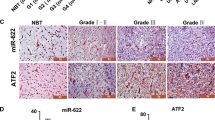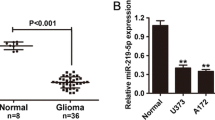Abstract
MicroRNAs can coordinately repress multiple target genes and interfere with the biological functions of the cell, such as proliferation and apoptosis. In the present study, we report that miR-200b was downregulated in malignant glioma cell lines and specimens. Overexpression of miR-200b suppressed the proliferation and colony formation of glioma cells. An oncogene encoding cAMP responsive element-binding protein 1 (CREB1), which has been shown to be an important transcription factor involved in the proliferation, survival, and metastasis of tumor cells, was here confirmed as a direct target gene of miR-200b. CREB1 was also found to be present at a high level in human glioma tissues. This was inversely correlated with miR-200b expression. Ectopic expression of CREB1 attenuated the growth suppressive phenotypes of glioma cells caused by miR-200b. These results indicate that miR-200b targets the CREB1 gene and suppresses glioma cell growth, suggesting that miR-200b shows tumor-suppressive activity in human malignant glioma.




Similar content being viewed by others
References
Clarke J, Butowski N, Chang S (2010) Recent advances in therapy for glioblastoma. Arch Neurol 67:279–283. doi:10.1001/archneurol.2010.5
Inui M, Martello G, Piccolo S (2010) MicroRNA control of signal transduction. Nat Rev Mol Cell Biol 11:252–263. doi:10.1038/nrm2868
Zimmerman AL, Wu S (2011) MicroRNAs, cancer and cancer stem cells. Cancer Lett 300:10–19. doi:10.1016/j.canlet.2010.09.019
Lu J, Getz G, Miska EA, Alvarez-Saavedra E, Lamb J, Peck D, Sweet-Cordero A, Ebert BL, Mak RH, Ferrando AA, Downing JR, Jacks T, Horvitz HR, Golub TR (2005) MicroRNA expression profiles classify human cancers. Nature 435:834–838. doi:10.1038/nature03702
Volinia S, Calin GA, Liu CG, Ambs S, Cimmino A, Petrocca F, Visone R, Iorio M, Roldo C, Ferracin M, Prueitt RL, Yanaihara N, Lanza G, Scarpa A, Vecchione A, Negrini M, Harris CC, Croce CM (2006) A microRNA expression signature of human solid tumors defines cancer gene targets. Proc Natl Acad Sci U S A 103:2257–2261. doi:10.1073/pnas.0510565103
Calin GA, Croce CM (2006) MicroRNA signatures in human cancers. Nat Rev Cancer 6:857–866. doi:10.1038/nrc1997
Chen CZ (2005) MicroRNAs as oncogenes and tumor suppressors. N Engl J Med 353:1768–1771. doi:10.1056/NEJMp058190
Iorio MV, Visone R, Di Leva G, Donati V, Petrocca F, Casalini P, Taccioli C, Volinia S, Liu CG, Alder H, Calin GA, Menard S, Croce CM (2007) MicroRNA signatures in human ovarian cancer. Cancer Res 67:8699–8707. doi:10.1158/0008-5472.CAN-07-1936
Elson-Schwab I, Lorentzen A, Marshall CJ (2010) MicroRNA-200 family members differentially regulate morphological plasticity and mode of melanoma cell invasion. PLoS One 5. doi: 10.1371/journal.pone.0013176
Adam L, Zhong M, Choi W, Qi W, Nicoloso M, Arora A, Calin G, Wang H, Siefker-Radtke A, McConkey D, Bar-Eli M, Dinney C (2009) miR-200 expression regulates epithelial-to-mesenchymal transition in bladder cancer cells and reverses resistance to epidermal growth factor receptor therapy. Clin Cancer Res 15:5060–5072. doi:10.1158/1078-0432
Korpal M, Lee ES, Hu G, Kang Y (2008) The miR-200 family inhibits epithelial-mesenchymal transition and cancer cell migration by direct targeting of E-cadherin transcriptional repressors ZEB1 and ZEB2. J Biol Chem 283:14910–14914. doi:10.1074/jbc.C800074200
Burk U, Schubert J, Wellner U, Schmalhofer O, Vincan E, Spaderna S, Brabletz T (2008) A reciprocal repression between ZEB1 and members of the miR-200 family promotes EMT and invasion in cancer cells. EMBO Rep 9:582–589. doi:10.1038/embor.2008.74
Leskela S, Leandro-Garcia LJ, Mendiola M, Barriuso J, Inglada-Perez L, Munoz I, Martinez-Delgado B, Redondo A, de Santiago J, Robledo M, Hardisson D, Rodriguez-Antona C (2011) The miR-200 family controls beta-tubulin III expression and is associated with paclitaxel-based treatment response and progression-free survival in ovarian cancer patients. Endocr Relat Cancer 18:85–95. doi:10.1677/ERC-10-0148
Xia W, Li J, Chen L, Huang B, Li S, Yang G, Ding H, Wang F, Liu N, Zhao Q, Fang T, Song T, Wang T, Shao N (2010) MicroRNA-200b regulates cyclin D1 expression and promotes S-phase entry by targeting RND3 in HeLa cells. Mol Cell Biochem 344:261–266. doi:10.1007/s11010-010-0550-2
Zhang X, Odom DT, Koo SH, Conkright MD, Canettieri G, Best J, Chen H, Jenner R, Herbolsheimer E, Jacobsen E, Kadam S, Ecker JR, Emerson B, Hogenesch JB, Unterman T, Young RA, Montminy M (2005) Genome-wide analysis of cAMP-response element binding protein occupancy, phosphorylation, and target gene activation in human tissues. Proc Natl Acad Sci U S A 102:4459–4464. doi:10.1073/pnas.0501076102
Boni V, Bitarte N, Cristobal I, Zarate R, Rodriguez J, Maiello E, Garcia-Foncillas J, Bandres E (2010) miR-192/miR-215 influence 5-fluorouracil resistance through cell cycle-mediated mechanisms complementary to its post-transcriptional thymidilate synthase regulation. Mol Cancer Ther 9:2265–2275. doi:10.1158/1535-7163.MCT-10-0061
Zhu W, Shan X, Wang T, Shu Y, Liu P (2010) miR-181b modulates multidrug resistance by targeting BCL2 in human cancer cell lines. Int J Cancer 127:2520–2529. doi:10.1002/ijc.25260
Pan YZ, Morris ME, Yu AM (2009) MicroRNA-328 negatively regulates the expression of breast cancer resistance protein (BCRP/ABCG2) in human cancer cells. Mol Pharmacol 75:1374–1379. doi:10.1124/mol.108.054163
Park SM, Gaur AB, Lengyel E, Peter ME (2008) The miR-200 family determines the epithelial phenotype of cancer cells by targeting the E-cadherin repressors ZEB1 and ZEB2. Genes Dev 22:894–907. doi:10.1101/gad.1640608
Gregory PA, Bert AG, Paterson EL, Barry SC, Tsykin A, Farshid G, Vadas MA, Khew-Goodall Y, Goodall GJ (2008) The miR-200 family and miR-205 regulate epithelial to mesenchymal transition by targeting ZEB1 and SIP1. Nat Cell Biol 10:593–601. doi:10.1038/ncb1722
Feng B, Wang R, Chen LB (2012) Review of miR-200b and cancer chemosensitivity. Biomed Pharmacother 66:397–402. doi:10.1016/j.biopha.2012.06.002
Shaywitz AJ, Greenberg ME (1999) CREB: a stimulus-induced transcription factor activated by a diverse array of extracellular signals. Annu Rev Biochem 68:821–861. doi:10.1146/annurev.biochem.68.1.821
Mayr B, Montminy M (2001) Transcriptional regulation by the phosphorylation-dependent factor CREB. Nat Rev Mol Cell Biol 2:599–609. doi:10.1038/35085068
Pigazzi M, Ricotti E, Germano G, Faggian D, Arico M, Basso G (2007) cAMP response element binding protein (CREB) overexpression CREB has been described as critical for leukemia progression. Haematologica 92:1435–1437. doi:10.3324/haematol.11122
Shankar DB, Cheng JC, Kinjo K, Federman N, Moore TB, Gill A, Rao NP, Landaw EM, Sakamoto KM (2005) The role of CREB as a proto-oncogene in hematopoiesis and in acute myeloid leukemia. Cancer Cell 7:351–362. doi:10.1016/j.ccr.2005.02.018
Lee JA, Kim H, Lee YS, Kaang BK (2003) Overexpression and RNA interference of Ap-cyclic AMP-response element binding protein-2, a repressor of long-term facilitation, in Aplysia kurodai sensory-to-motor synapses. Neurosci Lett 337:9–12
Acknowledgments
This study was supported by the Basilic Special Financial Support of Affiliated Cancer Hospital Guangzhou Medical University (2010-yz-01).
Author information
Authors and Affiliations
Corresponding author
Additional information
Biao Peng and Su Hu contributed equally to this study.
Rights and permissions
About this article
Cite this article
Peng, B., Hu, S., Jun, Q. et al. MicroRNA-200b targets CREB1 and suppresses cell growth in human malignant glioma. Mol Cell Biochem 379, 51–58 (2013). https://doi.org/10.1007/s11010-013-1626-6
Received:
Accepted:
Published:
Issue Date:
DOI: https://doi.org/10.1007/s11010-013-1626-6




